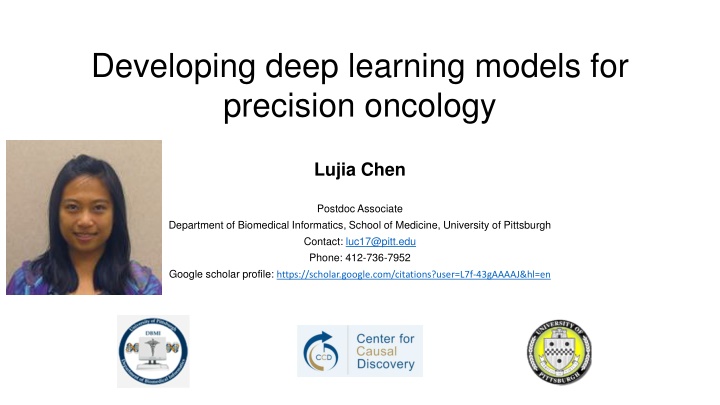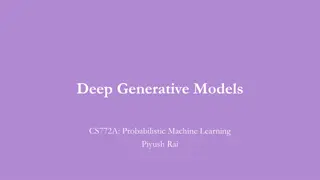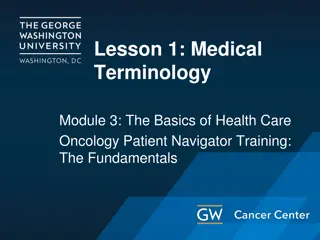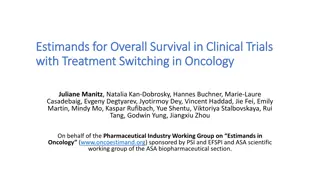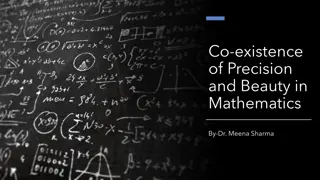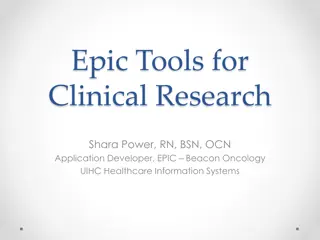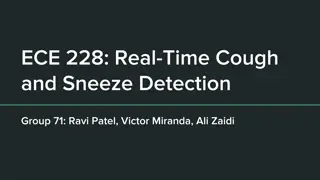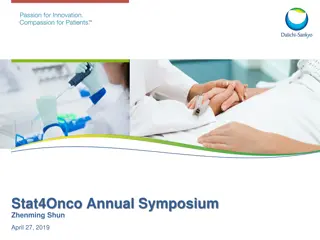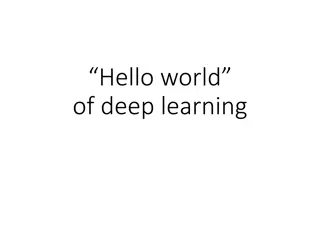Precision Oncology Research using Deep Learning Models
Lujia Chen, a Postdoc Associate at the University of Pittsburgh, focuses on developing deep learning models for precision oncology. By utilizing machine learning, especially deep learning models, Chen aims to identify cancer signaling pathways, predict drug sensitivities, and personalize cancer treatment based on genomic data. The research also involves simulating cellular signaling systems and selecting candidate drugs based on individual patient genomic profiles. Chen's work has been supported by NIH funding and has been published in reputable journals.
Download Presentation

Please find below an Image/Link to download the presentation.
The content on the website is provided AS IS for your information and personal use only. It may not be sold, licensed, or shared on other websites without obtaining consent from the author.If you encounter any issues during the download, it is possible that the publisher has removed the file from their server.
You are allowed to download the files provided on this website for personal or commercial use, subject to the condition that they are used lawfully. All files are the property of their respective owners.
The content on the website is provided AS IS for your information and personal use only. It may not be sold, licensed, or shared on other websites without obtaining consent from the author.
E N D
Presentation Transcript
Developing deep learning models for precision oncology Lujia Chen Postdoc Associate Department of Biomedical Informatics, School of Medicine, University of Pittsburgh Contact: luc17@pitt.edu Phone: 412-736-7952 Google scholar profile: https://scholar.google.com/citations?user=L7f-43gAAAAJ&hl=en
Major goals of current research Uses machine learning, especially deep learning models, to simulate the hierarchical organization of cellular signaling systems and to systematically identify major cancer signaling pathways. Detect tumor-specific aberrations in signaling pathways, and predict cancer cells sensitivity to anti- cancer drugs, which help guide the personalized treatment based on patients individual genomic status. Use individual patient s genomic data (e.g. bulk RNA-seq and single-cell RNA-seq) to select candidate drugs (single drug/drug combination) and predict drug response rate. Provide insights on gene signatures and representation of cell signaling pathways that are most sensitive to drug response. Publications: 1. Ding, M.Q., Chen, L., Cooper G.F., Young, J.D., Lu X. (2018) Precision Oncology beyond Targeted Therapy: Combining Omics Data with Machine Learning Matches the Majority of Cancer Cells to Effective Therapeutics, Molecular cancer research : MCR, 16, 269-278. 2. Chen, L., Cai C., Chen V., Lu X. (2016) Learning a hierarchical representation of the yeast transcriptomic machinery using an autoencoder model, BMC bioinformatics, 17 Suppl 1, 9. Funding Support: Developing deep learning models for precision oncology (PI, NIH K99, Dec 2019 -- Nov 2021)
A B Tumors Literature Tumor Gene Gene Summary R401W A147G G135K G135R R655H E325K Somatic Mutation Somatic Copy Number Alteration Generifs RNA Expression C Semantic Representation Word Vectors D Document Representation 500 Count TP53 . . . . . cancer mdm2 mutat akt cancer pathwai pten akt cancer cell kra pathwai associ endometri phosphatas tumor MDM2 PTEN . . . 0 Tumor tp53 p53 cell p53-dependent apoptosi pten kra pathwai pik3ca pi3k mutat akt associ ubiquitin risk endometri phosphatas ... TP53 PIK3CA Words 500 . . . Count PIK3CA Deep Learning for precision oncology 0 Words G F Topics E Survival Clusters Topic& 127 Words gata3 gata% 3 t% bet th2 express breast th1 allerg cell patient akr1c1 foxa1 syndrom deaf il% 5 eczema asthma regul rhiniti cancer mc cdx2 data regul risk Topic-127 Topic-37 Topic-6 mdm2 Topic-11 Topic& 37 Words muc2 mucin muc5b muc5ac mucu muc1 intestin goblet epitheli airwai express up6 regul pulmonari colorect colon secret gastric cf pathwai promot arg p53-mediat carcinoma Genes GATA3 TP53 EGFR APOB MIR21 ERBB2 CDH1 MYC TP63 CASP8 ADAM9 UGT1A1 SMAD4 CYP24A1 STK11 TGFBR2 HRAS KRAS SOX2 RPS6KB1 STK11 MAP2K4 MIR21 UGT1A1 NOTCH1 Association 1.28247085 0.96119618 0.70468593 0.31137892 0.28599206 0.24763458 0.23148058 0.18151049 0.16863047 0.14665959 0.09888575 0.08152494 0.0811151 0.07678474 0.0652695 0.06364729 0.0611566 0.06063471 0.05810657 0.04506786 0.04965118 0.18769644 0.1840329 1.15640583 1.13534016 11 p53 Topic& 6 Words cell cancer express associ activ tumor mutat patient carcinoma role result suggest increas factor human signal mutant p21 Genes MUC2 TP53 CDH1 KMT2A ERBB2 AR CCND1 CDKN2A APC PIK3CA KRAS NOTCH1 MUC5B HRAS MYC TP63 MUC17 PTEN VHL TP63 CCND1 TP63 Association 1.00522494 0.25286471 0.25074163 0.23578677 0.20822134 0.18874507 0.1835821 0.17267664 0.15604076 0.12720429 0.11367262 0.09253518 0.09120529 0.0869529 0.08251222 0.08077259 0.07409559 0.07191031 0.05913765 0.19016088 1.21631867 1.20620734 1.0 Topic& 11 Words tp53 p53 mdm2 apoptosi p53-depend codon dna pro mutat cell damag polymorph cancer tumor cluster=1 cluster=3 cluster=4 cluster=6 cluster=7 cluster=8 Genes AR TP53 CCND1 ERBB2 MET HRAS CASP8 CDKN2A PIK3CA APOB SOX2 NOTCH1 PHB RB1 FOXA1 RYR1 EGFR NFE2L2 Association 3.09061641 2.25003913 1.5369122 0.80307053 0.68931314 0.61917982 0.61279385 0.5414145 0.31721944 0.26216548 0.24094816 0.23819633 0.22671785 0.21844201 0.21317454 0.21088065 0.20662747 1.2958898 Genes TP53 PTEN KRAS CDKN2A MDM4 AR RB1 EGFR CTNNB1 MYC EP300 PIK3CA MET NOS2 APC Association 65.9663397 4.94983647 4.25146903 3.45404038 3.41412478 2.91315345 2.74728124 2.47026594 2.4329078 2.22139699 1.68051411 1.66184495 1.63612722 1.45055839 1.3802165 A B Tumors Literature 0.8 e.g. Deep Autoencoder Survival Probability 0.6 Tumor Gene Samples 0.4 Gene Summary R401W A147G G135K G135R R655H E325K Somatic Mutation 0.2 Somatic Copy Number Alteration Generifs 0.0 0 1000 2000 3000 4000 5000 6000 RNA Expression Days Samples Personalized medicine Cancer Subtype Analysis Gene Modules/Pathways C Semantic Representation Word Vectors D Document Representation Gn G1 G2 Genomic Data (single-cell and bulk-cell) 500 Count TP53 . . . . . T1 cancer mdm2 mutat akt cancer pathwai pten akt cancer cell kra pathwai associ endometri phosphatas tumor MDM2 PTEN . . . 0 Tumor Tumors Deep Learning Model tp53 p53 cell p53-dependent apoptosi pten kra pathwai pik3ca pi3k mutat akt associ ubiquitin risk endometri phosphatas ... TP53 PIK3CA T2 Words 500 . . . Count PIK3CA 0 Drug prediction Tm Words Tumor Representation G Drug Sensitivity Analysis F Topics E Survival Clusters Topic& 127 Words gata3 gata% 3 t% bet th2 express breast th1 allerg cell patient akr1c1 foxa1 syndrom deaf il% 5 eczema asthma regul rhiniti cancer mc cdx2 data regul risk Topic-127 Topic-37 Topic-6 mdm2 Topic-11 Topic& 37 Words muc2 mucin muc5b muc5ac mucu muc1 intestin goblet epitheli airwai express up6 regul pulmonari colorect colon secret gastric cf pathwai promot arg p53-mediat carcinoma Genes GATA3 TP53 EGFR APOB MIR21 ERBB2 CDH1 MYC TP63 CASP8 ADAM9 UGT1A1 SMAD4 CYP24A1 STK11 TGFBR2 HRAS KRAS SOX2 RPS6KB1 STK11 MAP2K4 MIR21 UGT1A1 NOTCH1 Association 1.28247085 0.96119618 0.70468593 0.31137892 0.28599206 0.24763458 0.23148058 0.18151049 0.16863047 0.14665959 0.09888575 0.08152494 0.0811151 0.07678474 0.0652695 0.06364729 0.0611566 0.06063471 0.05810657 0.04506786 0.04965118 0.18769644 0.1840329 1.15640583 1.13534016 11 p53 Topic& 6 Words cell cancer express associ activ tumor mutat patient carcinoma role result suggest increas factor human signal mutant p21 Genes MUC2 TP53 CDH1 KMT2A ERBB2 AR CCND1 CDKN2A APC PIK3CA KRAS NOTCH1 MUC5B HRAS MYC TP63 MUC17 PTEN VHL TP63 CCND1 TP63 Association 1.00522494 0.25286471 0.25074163 0.23578677 0.20822134 0.18874507 0.1835821 0.17267664 0.15604076 0.12720429 0.11367262 0.09253518 0.09120529 0.0869529 0.08251222 0.08077259 0.07409559 0.07191031 0.05913765 0.19016088 1.21631867 1.20620734 1.0 Topic& 11 Words tp53 p53 mdm2 apoptosi p53-depend codon dna pro mutat cell damag polymorph cancer tumor cluster=1 cluster=3 cluster=4 cluster=6 cluster=7 cluster=8 Genes AR TP53 CCND1 ERBB2 MET HRAS CASP8 CDKN2A PIK3CA APOB SOX2 NOTCH1 PHB RB1 FOXA1 RYR1 EGFR NFE2L2 Association 3.09061641 2.25003913 1.5369122 0.80307053 0.68931314 0.61917982 0.61279385 0.5414145 0.31721944 0.26216548 0.24094816 0.23819633 0.22671785 0.21844201 0.21317454 0.21088065 0.20662747 1.2958898 Genes TP53 PTEN KRAS CDKN2A MDM4 AR RB1 EGFR CTNNB1 MYC EP300 PIK3CA MET NOS2 APC Association 65.9663397 4.94983647 4.25146903 3.45404038 3.41412478 2.91315345 2.74728124 2.47026594 2.4329078 2.22139699 1.68051411 1.66184495 1.63612722 1.45055839 1.3802165 0.8 Survival Probability 0.6 Drug response Samples 0.4 Diagonosis 0.2 e.g. Topic Modeling 0.0 0 1000 2000 3000 4000 5000 6000 Days Samples Survival Analysis Publications: 1. Ding, M.Q., Chen, L., Cooper G.F., Young, J.D., Lu X. (2018) Precision Oncology beyond Targeted Therapy: Combining Omics Data with Machine Learning Matches the Majority of Cancer Cells to Effective Therapeutics, Molecular cancer research : MCR, 16, 269-278. 2. Cai, C., et al. (2019) Systematic Discovery of the Functional Impact of Somatic Genome Alterations in Individual Tumors through Tumor-specific Causal Inference, PLoS Comput Biol. 3. Chen, L., Cai C., Chen V., Lu X. (2016) Learning a hierarchical representation of the yeast transcriptomic machinery using an autoencoder model, BMC bioinformatics, 17 Suppl 1, 9.
Develop Deep Learning Models (DLMs) for drug prediction Develop DLMs to simulate the hierarchical organization of cellular signaling systems and to systematically identify major cancer signaling pathways. Use the representations of cancer signaling pathways to improve the drug response prediction. Example of three DLM multi-task learning models (A) Supervised DLM with intermediate shared deep hidden layers and drug specific hidden layer on top. (B) Supervised DLM with multi-task classifier; (C) Semi-supervised DLM using hidden representation learned from unsupervised DLM with multi- task classifier. Publications: 1. Chen, L., Lu, X. (2018) Discovering functional impacts of miRNAs in cancers using a causal deep learning model, BMC medical genomics, 11, 116. 2. Lu, S., Fan, X., Chen, L., Lu, X. (2018) A novel method of using Deep Belief Networks and genetic perturbation data to search for yeast signaling pathways, Plos One, 13, 9. 3. Chen, L., Cai C., Chen V., Lu X. (2016) Learning a hierarchical representation of the yeast transcriptomic machinery using an autoencoder model, BMC bioinformatics, 17 Suppl 1, 9. 4. Chen, L., Cai C., Chen V., Lu X. (2015) Trans-species learning of cellular signaling systems with bimodal deep belief networks, Bioinformatics, 31, 3008-3015.
Deep Learning in Precision Oncology Develop and apply machine learning especially deep learning models and causal discovery, to systematically identify major cancer signaling pathways in cancer patients to improve the discovery of gene signature biomarkers and drug response prediction. Collaborators in the following areas: Artificial Intelligence especially Deep Learning Cancer biology Drug discovery Immunotherapy
